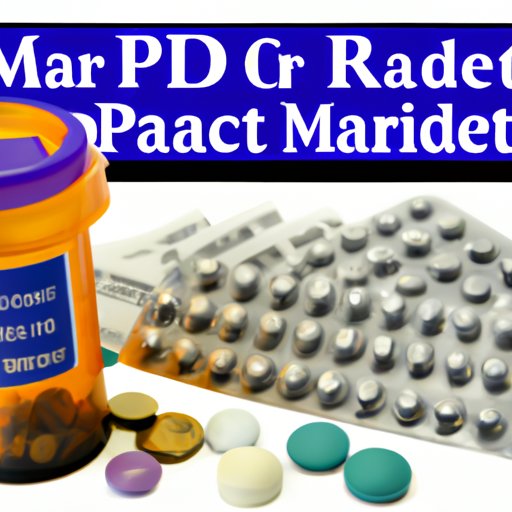Introduction
Medicare Part D is an important part of the Medicare program that helps cover the cost of prescription drugs for those enrolled in Medicare. It is an optional benefit for Medicare recipients and helps cover the cost of medications prescribed by a doctor. This article will provide an overview of Part D, how it works, and the benefits of enrolling in the program.
Exploring Part D of Medicare: What It Is and How It Works
Part D of Medicare is a voluntary prescription drug coverage plan available to those enrolled in Original Medicare (Parts A and B). Part D helps pay for both generic and brand name drugs prescribed by a doctor. Part D plans are provided through private insurance companies that have been approved by Medicare. Enrollment in Part D is optional but can help reduce the cost of prescription drugs.
Enrollment Requirements
In order to be eligible for Part D coverage, you must be enrolled in Original Medicare (Parts A and B). You must also live in the service area of the Part D plan you are considering. If you already have other prescription drug coverage, such as through an employer or union, you may not need Part D coverage. However, it is important to check with your provider to ensure that all of your medications are covered by your existing plan.
Eligibility
Most people who are eligible for Medicare are eligible for Part D coverage. Those who are eligible for Medicare include people over the age of 65, certain younger individuals with disabilities, and individuals with End-Stage Renal Disease (ESRD).
Coverage
Part D coverage can vary from one plan to another. Most plans will cover both generic and brand name drugs, although some may not cover certain types of drugs. All plans will require you to pay a monthly premium for coverage, as well as a deductible before your coverage begins. You may also be required to pay a copayment or coinsurance for each prescription drug you receive.
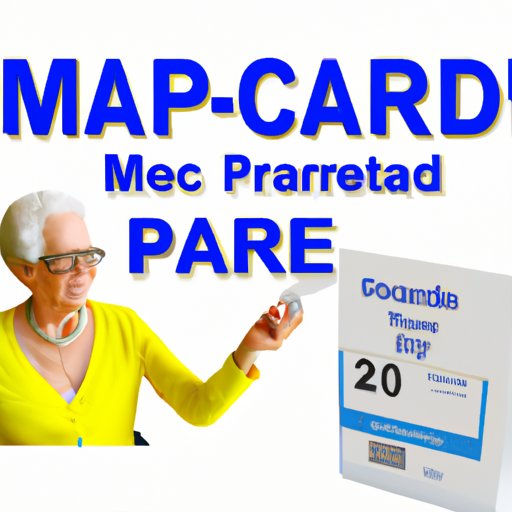
A Comprehensive Guide to Medicare Part D Coverage
Part D plans are offered by private insurance companies that have been approved by Medicare. Each plan will have different coverage, so it is important to compare plans to find one that best meets your needs. Here is a comprehensive guide to understanding Part D coverage.
Types of Coverage
Part D plans offer either basic coverage or enhanced coverage. Basic coverage covers most generic and brand name drugs, while enhanced coverage may also cover additional drugs, such as specialty drugs. It is important to understand the differences between the two types of coverage when comparing plans.
Prescription Drugs Covered
Part D plans cover both generic and brand name drugs. However, not all plans cover all drugs, so it is important to check with your plan to make sure that the drugs you need are covered. Additionally, some plans may require prior authorization for certain drugs.
Formularies
Part D plans use formularies to determine which drugs are covered and which are not. A formulary is a list of drugs that are covered by the plan. Some plans may have more limited formularies than others, so it is important to review the formulary of any plan you are considering.
An Overview of Medicare Part D for Seniors
Part D is especially beneficial for seniors, as it can help reduce the cost of prescription drugs. Here is an overview of Part D for seniors.
Eligibility for Seniors
Seniors who are eligible for Medicare are also eligible for Part D coverage. To be eligible for Part D, you must be enrolled in Original Medicare (Parts A and B).
Cost-Sharing Options
Part D plans may require you to pay a monthly premium, a deductible, and a copayment or coinsurance for each drug you receive. The amount you pay will depend on the type of plan you choose and the drugs you need.
Extra Help Programs
Some seniors may qualify for extra help with their Part D costs. The Extra Help program helps pay for premiums, deductibles, and coinsurance or copayments associated with Part D. To see if you qualify for extra help, visit the Social Security Administration website.
The Benefits of Enrolling in Medicare Part D
There are many benefits to enrolling in Part D, including access to prescription drugs, lower prescription drug costs, and peace of mind. Here are some of the benefits of enrolling in Part D.
Access to Prescription Drugs
Part D helps cover the cost of prescription drugs, which can be expensive without coverage. With Part D, you can get the medications you need at a lower cost.
Lower Prescription Drug Costs
Part D can help reduce the cost of prescription drugs. Many Part D plans offer discounts on generic and brand name drugs, which can help save money.
Peace of Mind
Part D provides peace of mind by ensuring that you have access to the medications you need. Knowing that you have coverage can give you peace of mind and help you manage your health.
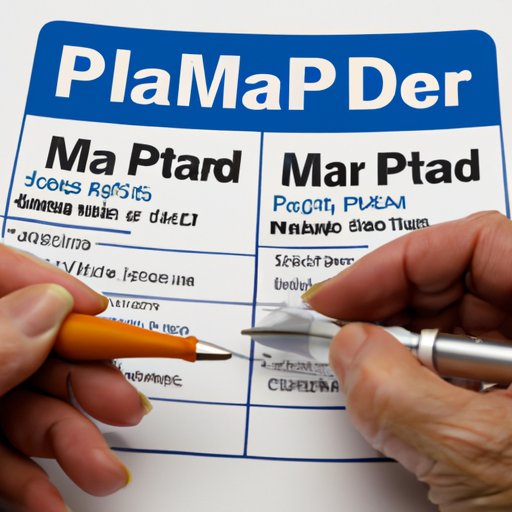
Comparing Medicare Part D Plans
When choosing a Part D plan, it is important to compare plans to find one that best meets your needs. Here are some tips for comparing plans.
Different Types of Plans
Part D plans come in different types, including basic and enhanced coverage. It is important to understand the differences between the two types of plans when comparing them.
Analyzing Costs
It is also important to analyze the costs associated with each plan. Consider factors such as the monthly premium, deductible, copayments, and coinsurance when comparing plans.
Choosing the Right Plan
When choosing a plan, it is important to consider your individual needs. Make sure the plan covers the drugs you need and offers the coverage you need at a price you can afford.
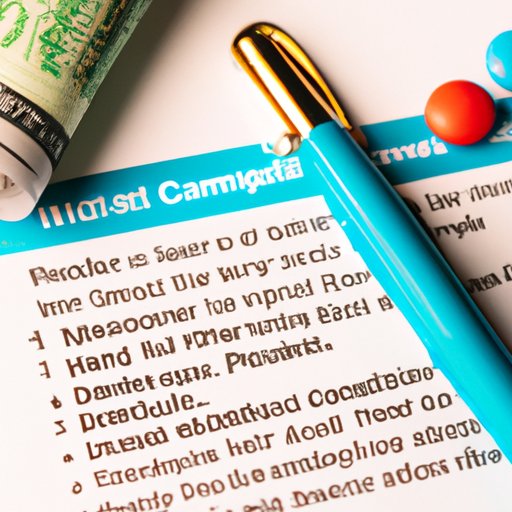
Understanding Costs and Deductibles with Medicare Part D
Part D plans require you to pay a monthly premium, a deductible, and a copayment or coinsurance for each drug you receive. Here is an overview of these costs.
Understanding Deductibles
A deductible is the amount you must pay before your Part D coverage begins. The amount of the deductible varies depending on the plan you choose. Some plans may have no deductible, while others may have a higher deductible.
Out-of-Pocket Maximums
Part D plans also have an out-of-pocket maximum. This is the maximum amount you will have to pay for your prescriptions each year. Once you reach this amount, your Part D coverage will pay for the rest of your prescriptions for the year.
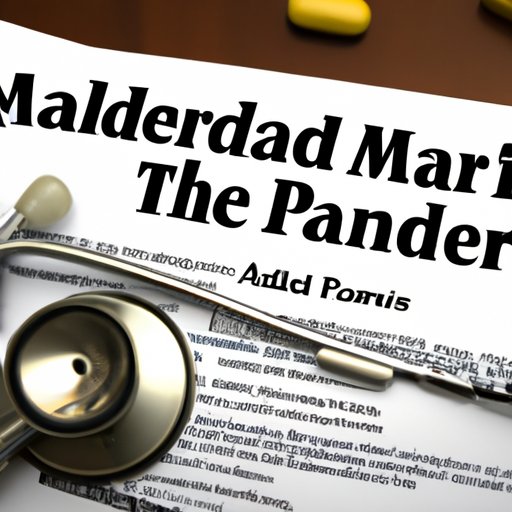
Unraveling the Mysteries of Medicare Part D
Part D can be confusing, but understanding how it works can help you make the most of your coverage. Here are some common misconceptions about Part D and tips for navigating the system.
Common Misconceptions
One common misconception about Part D is that it only covers generic drugs. In fact, Part D plans cover both generic and brand name drugs. Additionally, Part D plans are not the same as Medicare Advantage plans, which are separate from Part D.
Tips for Navigating the System
When it comes to Part D, it is important to do your research and understand the coverage you are getting. Compare plans to find one that best meets your needs and budget. Additionally, it is important to keep track of your prescriptions and monitor your spending to ensure you are getting the most out of your coverage.
Conclusion
Part D of Medicare is an important part of the Medicare program that helps cover the cost of prescription drugs. It is an optional benefit for those enrolled in Original Medicare, and enrollment can help reduce the cost of medications. This article provided an overview of Part D, how it works, and the benefits of enrolling in the program. It also explored the costs associated with Part D and provided tips for navigating the system. Understanding Part D can help you make the most of your coverage.
Summary
Part D of Medicare is an optional benefit that helps cover the cost of prescription drugs for those enrolled in Original Medicare. It is provided through private insurance companies that have been approved by Medicare, and it can help reduce the cost of medications. Part D plans require you to pay a monthly premium, a deductible, and a copayment or coinsurance for each drug you receive. There are many benefits to enrolling in Part D, including access to prescription drugs, lower prescription drug costs, and peace of mind. Understanding Part D can help you make the most of your coverage.
Final Thoughts
Part D of Medicare is an important part of the Medicare program that can help reduce the cost of prescription drugs. It is important to understand Part D and compare plans to find one that best meets your needs. With the right plan, you can get the medications you need at a lower cost and have peace of mind knowing that you are covered.
(Note: Is this article not meeting your expectations? Do you have knowledge or insights to share? Unlock new opportunities and expand your reach by joining our authors team. Click Registration to join us and share your expertise with our readers.)
